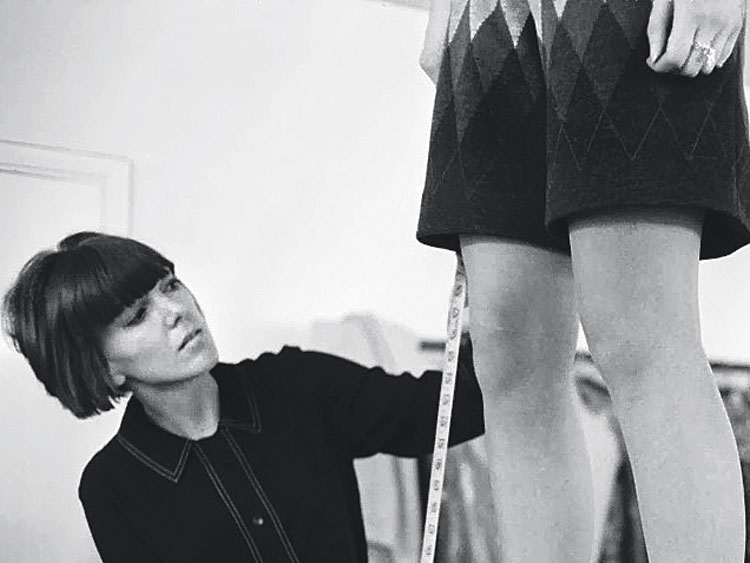The miniskirt, the focus of a new exhibition at the Victoria & Albert Museum, was a political statement by the fashion designer, Mary Quant, in London of the Swinging Sixties. It was a revolutionary act when she turned up at Buckingham Palace to receive her Order of the British Empire from the Queen “dressed in a cream wool jersey minidress with blue facings”.
“For those who didn’t live through it, it’s hard to imagine just how shocking miniskirts were when Mary Quant first made them famous in the 1960s,” notes the fashion writer, Hannah Rochell. Half a century on, the miniskirt is here to stay. Quant, now 89, is quoted as saying: “The miniskirt was a symbol of the growing confidence of the young of that time as they broke away from the rules and inhibitions of the post-war period. Rejecting clothing previously worn by their mothers, they wanted freedom and fun — and the shorter skirts enabled much more movement, whether running for a bus or going straight from work to dance at a club, just perhaps changing the accessories.”
The V&A currently also has its most successful exhibition for years, Christian Dior: Designer of Dreams. “Mary Quant is actually a designer who actively fought against the couture houses such as Dior so it is interesting to have them both in the museum,” says the V&A’s spokesman, Jordon Lewis. “Quant is about democratizing fashion, returning good quality fashion to the High Street as the founder of the miniskirt.” He explains how the V&A’s display “looks at the myth of the miniskirt — people thought Mary Quant invented it overnight. But actually we show how over the years her hemlines got higher as times were changing in London. People wanted their own identity... for the first time youth culture and street fashion really took a hold.”

Bidding adieu WikimediaCommons
Painful farewell
The BBC Radio 4 programme, Something Understood, to which Sir Mark Tully has been a regular contributor for over two decades with his observations on everything from religion to music and philosophy, has now been killed off by the corporation apparently because of budget constraints. “I am sad about Something Understood,” says Mark, when I ask him about the cancellation of the programme. Along with countless other listeners, I shall miss Something Understood, not least because Mark always managed to weave in Indian references — such as the qawaali he could hear in Delhi’s Nizamuddin Dargah.
In his farewell episode of Something Understood, broadcast on Easter Sunday, Mark, now 83 years of age, decided to take a line from TS Eliot’s poem, Coker — “In my beginning is my end” — as his final theme. He also pointed out that the lovely short poem called “St Pancras Station, August 1915” by Vera Brittain expresses “the depth of sorrow there can be in an ending”. He repeated the last line: “One last blurred look through aching tear-dimmed eyes — And you were gone.”
He signed off on the programme by telling his listeners: “As I finish writing the last Something Understood I may ever write, I feel the sadness of ending 24 years of contributing to a programme which has introduced me to such a wide variety of music, poetry and prose and enabled me to meet philosophers, theologians, scientists and people from many other walks of life I would never have met.” The BBC has promised past editions of Something Understood will continue to be broadcast, but that is not the same thing.
Mark bid goodbye to the programme’s listeners with the words: “And, as for me, well, I will have to take TS Eliot’s advice for old men and become an explorer and who knows what beginning I might discover. So we end with our programme’s beginning — with Easter, the resurrection as a new beginning, the story told in Berlioz’s magnificent setting of the Resurrexit from the solemn mass.”
Frequent journeys
Once ‘proceeding to the United Kingdom for higher studies’ was a rather big thing, and a special kind of status was attached to those who were “England returned”. When my father took my brother and me back to Calcutta for a holiday two years after we had first arrived in England, a neighbour accused him of making the journey mundane — “dal-bhaat”.
The expression really applies to industry bigwigs, such as the ubiquitous director-general of the Confederation of Indian Industry, Chandrajit Banerjee, who had this to say at a meeting in London last week: “For us this is a home coming — I was here just a few weeks back. I keep coming here every alternate month or more.” This is not surprising, considering the fact that the latest Grant Thornton tracker report reveals that there are now 842 Indian companies in the UK, with combined revenues of £48 billion and providing jobs for 1,04,783 people.
Bloody end
In the casting for British TV dramas these days, the guiding principle is ‘diversity’, with a reasonable number of prominent roles going to black and brown actors. Sadly, it has not ended well for the popular Maya Sondhi, who played the policewoman, Maneet Bindra, in Line of Duty, the highest rated crime drama. She had her throat slit in the very first episode of the current series by gangsters in cahoots with bent coppers.

Indira Devi as a young girl with her mother, Chimnabai II Wikipedia
Evocative photographs of maharajas and maharanis who liked visiting fashionable studios in London in the early 20th century appear in Indian Nobility in Britain, at the National Portrait Gallery. Some reveal how “India made an important contribution to the war effort”. Those featured include the cricketer, Prince Ranjitsinhji, in military uniform; Sir Sayaji Rao III and Chimnabai II from Baroda; Indira Devi from Cooch Behar; and Sudharani Devi and Lalitarani Devi from Burdwan.











